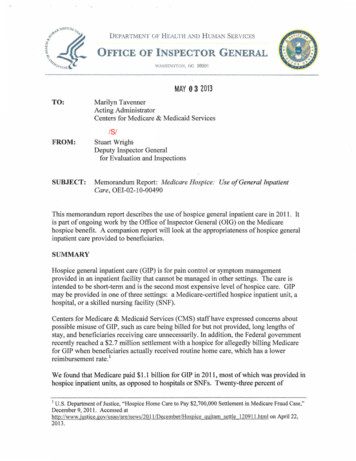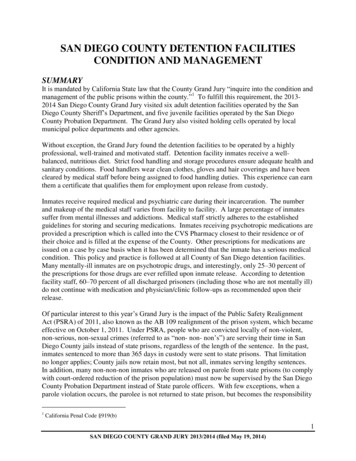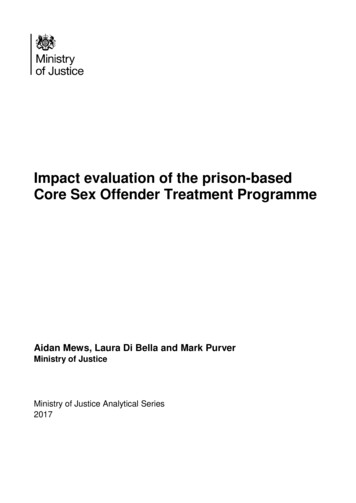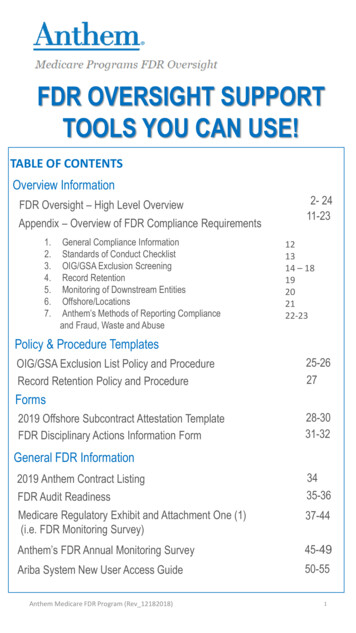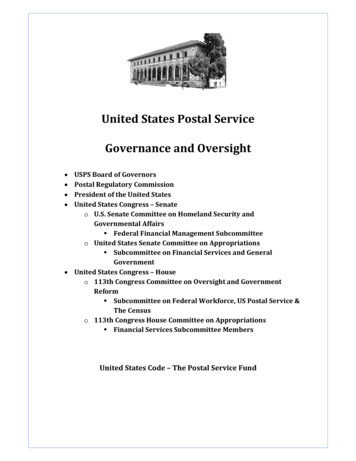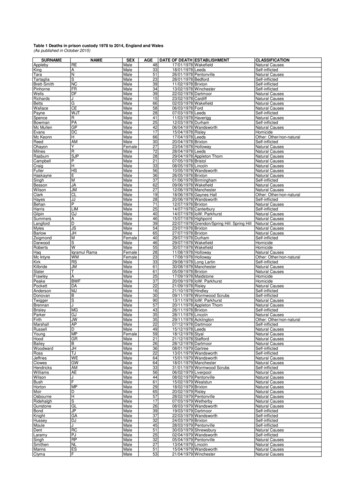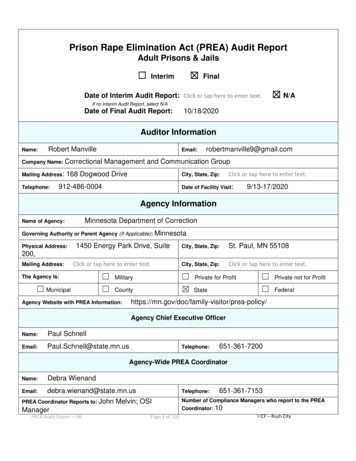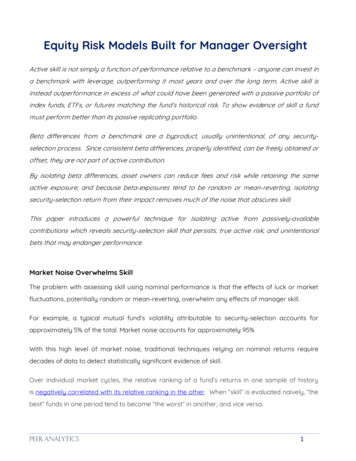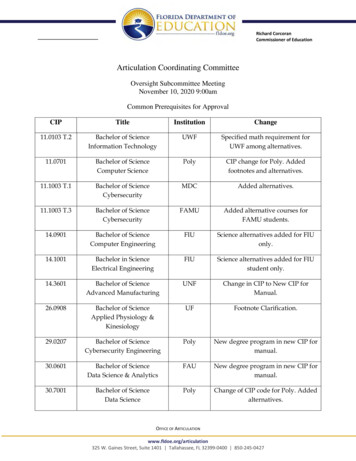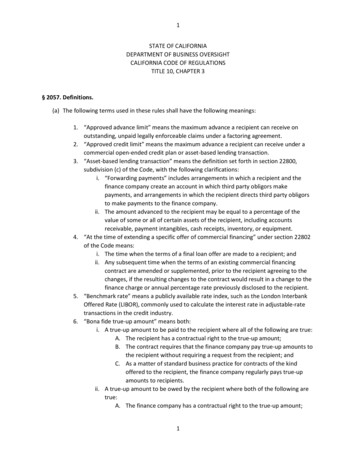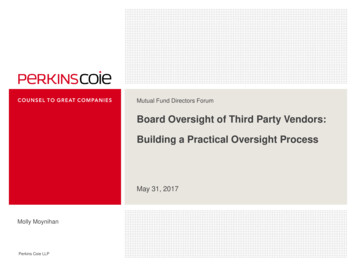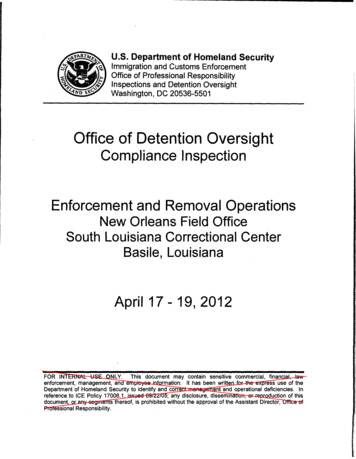
Transcription
U.S. Department of Homeland SecurityImmigration and Customs EnforcementOffice of Professional ResponsibilityInspections and Detention OversightWashington, DC 20536-5501Office of Detention OversightCompliance InspectionEnforcement and Removal OperationsNew Orleans Field OfficeSouth Louisiana Correctional CenterBasile, LouisianaApril17- 19, 2012FOR INTERNAL USE ONLY. This document may contain sensitive commercial, financial, lawenforcement, management, and employee information. It has been written for the express use of theDepartment of Homeland Security to identify and correct management and operational deficiencies. Inreference to ICE Policy 17006.1, issued 09/22/05; any disclosure, dissemination, or reproduction of thisdocument, or any segments thereof, is prohibited without the approval of the Assistant Director, Office ofProfessional Responsibility.
COMPLIANCE INSPECTIONSOUTH LOUISIANA CORRECTIONAL CENTERNEW ORLEANS FIELD OFFICETABLE OF CONTENTSEXECUTIVE SUMMARY . !INSPECTION PROCESSReport Organization . 5Inspection Team Members . 5OPERATIONAL ENVIRONMENTInternal Relations .·. 6Detainee Relations .6ICE PERFORMANCE BASED NATIONAL DETENTION STANDARDSDetention Standards Reviewed . 7Staff-Detainee Communication . 8Telephone Access . 9Use ofF orce and Restraints . 10
EXECUTIVE SUMMARYThe Office of Professional Responsibility (OPR), Office of Detention Oversight (ODO)conducted a Compliance Inspection (CI) of the South Louisiana Correctional Center (SLCC) inBasile, Louisiana from April17-19, 2012. SLCC opened in 1993, and is owned and operated byLCS Corrections Services, Incorporated (LCS). U.S. Immigration and Customs Enforcement(ICE), Office of Enforcement and Removal Operations (ERO) began housing detainees at SLCCin 2008 under an Intergovernmental Service Agreement. Male detainees of all securityclassification levels are detained at SLCC for periods in excess of72 hours. Female detaineesare not housed at the facility. Total housing capacity at SLCC is 1,017, with an allowance for amaximum of580 detainees; however, additional space can be made available ifnecessary. Atthe time ofthe CI, the facility housed 587 ICE detainees. The average length of stay is 30 days.The average daily detainee population is 318 detainees. SLCC also houses inmates from Stateand local law enforcement jurisdictions in Louisiana. SLCC provides medical care and foodservice at the facility. SLCC holds no accreditations.The ICE Office of Enforcement and Removal Operations (ERO), Field Office Director in NewOrleans, Louisiana (FOD/New Orleans) is responsible for ensuring facility compliance with ICEpolicies and the ICE Performance Based National Detention Standards (PBNDS). ERO has (b)(7)epermanently-assigned Deportation Officer (DO) physically located at SLCC. An Assistant FieldOffice Director (AFOD) and a Supervisory Detention and Deportation Officer (SDDO) at theERO Office in Oakdale, Louisiana maintain supervisory oversight ofiCE employees at SLCC.There is no Detention Service Manager (DSM) at SLCC. Previously, a DSM conductedoversight at both SLCC and the LaSalle Contract Detention Facility (CDF) in Jena, LA;however, in July 2011, the DSM was reassigned exclusively to the LaSalle CDF.The SLCC Warden is the highest ranking official at SLCC and is responsible for oversight ofdaily operations. Supervisory staff at SLCC is comprised of(b)(7)eDeputy ergeants, and (b)(7)e Corporals. The total number of non-ICE staff at SLCCis (b)(7)e The medical staff consists of(b)(7)eemployees, and includes a Medical Director, a HealthServices Administrator (HSA),(b)(7)eRegistered Nurses (RN),(b)(7)eLicensed Practical Nurses(LPN), a Medical Psychologist, a Mental Health Technician (MHT), a Physician AssistantCertified (PA-C), a Dentist,(b)(7)eCertified Nursing Assistants (CNA), and a Medical RecordsTechnician.In December 2008, ODO predecessor, the Detention Facilities Inspection Group (DFIG),conducted a Quality Assurance Review (QAR) of29 National Detention Standards at SLCC. Ofthe standards reviewed, seven were in full compliance. The remaining 22 standards accountedfor 81 deficiencies. In August 2009, a follow-up inspection was conducted that identified 21remaining uncorrected deficiencies in ten standards.In March 2012, ERO Detention Standards Compliance Unit contractor, Nakamoto Group, Inc.,conducted an annual review of the ICE PBNDS at SLCC. The facility received an overall ratingof"Meets Standards," and was found compliant with all40 standards reviewed.Office of Detention OversightApril2012OPR 201206917South Louisiana Correctional CenterERO New Orleans
During this CI, ODO reviewed a total of 14 PBNDS. Eleven standards were fully compliant.Three deficiencies were found in the remaining three standards: Staff-Detainee Communication(1 deficiency), Telephone Access (1), and Use ofForce and Restraints (1).This report details all deficiencies and refers to specific, relevant sections ofthe PBNDS. EROwill be provided a copy ofthe report to assist in developing corrective actions to resolve thethree identified deficiencies. These deficiencies were discussed with SLCC personnel on-siteduring the inspection, as well as during the close-out briefing conducted on April19, 2012.Overall, ODO found SLCC to be well-managed and in compliance with the standards inspected.ODO found SLCC policies and procedures were constructed using language found in thePBNDS to ensure compliance. The lack of deficiencies can be attributed to the use of a PBNDScompliance team at SLCC. ODO notes the establishment of this team as a best practice and acontributing factor to the exceptional level of compliance observed by ODO during this CI. ThePBNDS compliance team consists of a Deportation Officer (DO) and the SLCC ICE LiaisonOfficer. The SLCC ICE Liaison Officer is involved with oversight ofPBNDS issues at thefacility, and provides guidance and training to SLCC employees regarding the PBNDS. ThePBNDS Compliance Team provides oversight of SLCC adherence to the ICE PBNDS. The teamconducts facility visits, attends to all detainee correspondence, maintains records and logs, andaddresses issues affecting the health and welfare of detainees. Weekly meetings with facilitymanagement are held to discuss compliance issues or concerns observed by the team.During the CI, ODO observed SLCC intake officers interviewing detainees and creatingdetention files during the admission process. The facility has a site-specific orientation programand an orientation video that informs detainees about facility operations, rules, programs, andservices. Detainees undergo medical screenings by facility medical staff. SLCC does notroutinely conduct strip-searches of detainees unless reasonable suspicion exists that a detainee isconcealing contraband. All strip searches require supervisory approval. Every detainee receivesa copy of the ICE National Detainee Handbook and the local facility handbook. Both areavailable in English and Spanish, which are the predominant languages spoken by detainees atSLCC. Detainees are issued uniforms, bed linens, a blanket, towels, shower shoes,undergarments, socks, and hygiene supplies. Detainees are required to sign a formacknowledging receipt of facility-issued items prior to their actual issuance. ODO recommendsthe facility require detainees to fill out the acknowledgement when receiving facility-issuedproperty, after the items are actually issued to detainees as opposed to prior. This will ensuredetainees have the facility-issued items in their possession prior to completing theacknowledgment form, and the items issued match the items on the form.Food service operations are well-managed; no deficiencies were cited during a review of theFood Service PBNDS. All work associated with preparing meals is performed by employees ofLCS and an inmate work crew. Staff consists of a Food Service Administrator, a Food ServiceForeman, and three Security Officers. The facility serves meals in a central dining hall. ODOverified all menus are certified by a registered dietitian. Religious and medically-prescribedmeals are provided and properly documented. Review of required inspections and temperaturelogs verified compliance with the standard. ODO interviewed seven detainees in the dining hallduring a lunch meal; none voiced any complaints.Office of Detention OversightApril2012OPR 2012069172South Louisiana Correctional CenterERO New Orleans
ODO determined detainees have the opportunity to file informal and formal grievances, and toappeal grievance decisions. Detainee grievances are tracked in an electronic log maintained bythe Warden, and in a hardcopy logbook, which is maintained by the Deputy Warden. Both theelectronic and hardcopy logs were current and organized. ODO reviewed a sample of fourdetainee grievances filed during the 12 months preceding the inspection, and determined all fourhad been properly addressed. Interviews with the four detainees who had filed the reviewedgrievances confirmed all were aware ofthe grievance process; each detainee stated the grievancesystem functions as described in the detainee handbook. At the time of the CI, there were nounresolved grievances.ODO inspected the SLCC law library and found it to be adequately stocked with writingmaterials and mailing supplies. The computers available for use were equipped with the mostrecent version ofLexis-Nexis software. One area of concern noted by ODO was the size of thelaw library and the number of computers available for use by ICE detainees. ODO found the lawlibrary was equipped to hold a total of three people at any time, and had two computers availablefor use. Although the size of the law library appears to be inadequate for the population size,ODO found no grievances had been filed regarding access to the law library or legal materials.ODO noted no deficiencies during the review of the Medical Care PBNDS. The medical clinicwas found to be well-managed. ODO review of25 detainee medical records confirmed thatintake screening, testing for tuberculosis, dispensing of medication, special care, chronic care,follow-up care, and consent for treatment occur in all applicable cases. Detainees access care bysubmitting written medical requests, available in English and Spanish, into a locked box in thecafeteria. Medical requests are collected and triaged twice daily by medical staff. All detaineessubmitting medical requests are examined within 24 hours. ODO determined staffing issufficient to meet detainee health needs. Physical examinations (PE) are conducted by an RN.ODO reviewed proficiency statements signed by the Medical Director attesting that each RN hadbeen trained and approved to perform a PE. In all 25 cases reviewed, ODO verified the PE washands-on, performed within the 14-day timeframe, and reviewed by a Physician. The trainingrecords of the entire medical staff and(b)(7)eCorrectional Officers confirmed they had been trainedto respond to health-related emergencies within a four-minute response time. All reviewedpersonnel had current certifications in cardiopulmonary resuscitation (CPR) and first aid.Medical transfer summaries were included in the medical records of all detainees released ortransferred from SLCC.ODO verified written procedures govern placement of detainees in administrative segregation.ICE detainees requiring segregation are housed in three of four SMUs at SLCC. Inspection ofthe SMUs verified the units are well ventilated, adequately lit, appropriately heated, andmaintained in a sanitary condition. All cells are equipped with beds that are securely fastened tothe floor. Interviews with staff confirmed detainees are most commonly placed onadministrative segregation pending a disciplinary hearing for rules violations. Other reasonsinclude protective custody or known gang affiliations where continued presence in the generalpopulation would pose a security threat to the detainee, other detainees, or staff. At the time ofthe CI, there was one detainee in administrative segregation and no detainees in disciplinarysegregation. The detainee in administrative segregation stated he was placed there pending aOffice of Detention OversightApril2012OPR 2012069173South Louisiana Correctional CenterERO New Orleans
hearing for violation of institutional rules. The detainee provided ODO with a copy ofhisplacement order, which confirmed the placement was properly documented.ICE staff conducts daily scheduled and unannounced visits each week at SLCC to addressdetainee concerns. These visits are logged in housing unit logbooks. Interviews with SLCCstaff confirmed supervisory ICE staff does not conduct unannounced and unscheduled visits toactivity areas and housing units. ICE request forms are available to detainees in each housingunit, and a copy ofthe ICE visitation schedule is posted in each housing unit. A review ofiCErequests and the request logbook confirmed all detainees received a response within 72 hours, asrequired by the PBNDS.There have been no suicide attempts or detainee deaths at SLCC since the August 2009 ODOinspection. From April6-10, 2012, one detainee was placed on suicide watch. Review of themedical record in that case confirmed compliance with facility policy and the PBNDS. ODOverified screening for suicide potential occurs at intake, and detainees diagnosed as "at risk forsuicide" are referred to medical staff, then appropriately housed and monitored. ODO review ofthe SLCC Suicide Prevention Awareness training curriculum verified it covers requiredelements, including recognizing signs of suicidal thinking, facility referral procedures, suicideprevention techniques, responding to an in-progress suicide attempt, identification of suicide riskfactors, and the psychological profile of a suicidal detainee. An inspection of training records for(b)(7)ecustody staff and the entire medical staff confirmed all had received training duringorientation and on an annual basis.Prior to the CI, SLCC management did not provide accommodations for detainees requiringprivacy for telephone calls involving legal matters. At the time of the CI, legal calls werecompleted in the ICE Support Services Office where there was no allowance for privacy. Forsecurity reasons, officers were required to stand guard inside the office, creating the potential forthe telephone calls to be overheard. Prior to completion of the CI, SLCC management updatedthe telephone access policy, and detainee legal calls are now made with officer supervisionthrough an observation window. This allows calls to be made in private. Detainees havereasonable and equitable access to telephones at SLCC, and all telephones were in working orderat the time ofthe Cl.There were three calculated use-of-force incidents and one immediate use-of-force incident atSLCC between August 2011 and March 2012. Review ofvideo recordings and writtendocumentation on the three calculated use-of-force incidents confirmed compliance with thestandard, including completion of after-action reviews. ODO determined that reportsdocumenting and describing the one immediate force incident were also in compliance with thestandard; however, no after-action review was conducted. Review of documentation revealedthe immediate use-of-force incident involved the deployment of a chemical agent (OleoresinCapsicum) and the application of restraints.All detainees had access to daily recreation, visitation, and religious services, and were able tosend and receive mail.Office of Detention OversightApril2012OPR 2012069174South Louisiana Correctional CenterERO New Orleans
INSPECTION PROCESSODO inspections evaluate the welfare, safety, and living conditions of detainees. ODO primarilyfocuses on areas of noncompliance with the ICE National Detention Standards (NDS) or the ICEPBNDS, as applicable. The PBNDS apply to SLCC. In addition, ODO may focus its inspectionbased on detention management information provided by ERO Headquarters (HQ) and EROfield offices, and on issues of high priority or interest to ICE executive management.ODO reviewed the processes employed at SLCC to determine compliance with current policiesand detention standards. Prior to the inspection, ODO collected and analyzed relevantallegations and detainee information from multiple ICE databases, including the Joint IntegrityCase Management System (JICMS), the ENFORCE Alien Booking Module (EABM), and theENFORCE Alien Removal Module (EARM). ODO also gathered facility facts and inspectionrelated information from ERO HQ staff to prepare for the site visit at SLCC.REPORT ORGANIZATIONThis report documents inspection results, serves as an official record, and is intended to provideICE and detention facility management with a comprehensive evaluation of compliance withpolicies and detention standards. It summarizes those PBNDS that ODO found deficient in atleast one aspect of the standard. ODO reports convey information to best enable promptcorrective actions and to assist in the on-going process of incorporating best practices innationwide detention facility operations.OPR classifies program issues into one oftwo categories: deficiencies and areas of concern.OPR defines a deficiency as a violation of written policy that can be specifically linked to thePBNDS, ICE policy, or operational procedure. OPR defines an area of concern as somethingthat may lead to or risk a violation ofthe PBNDS, ICE policy, or operational procedure. Whenpossible, the report includes contextual and quantitative information relevant to the citedstandard. Deficiencies are highlighted in bold throughout the report and are encodedsequentially according to a detention standard designator.Comments and questions regarding the report findings should be forwarded to the DeputyDivision Director, OPR Office ofDetention Oversight.INSPECTION TEAM MEMBERS(b)(6), (b)(7)cODO, HoustonODO, HoustonODO, HoustonCreative CorrectionsCreative CorrectionsCreative CorrectionsSpecial Agent (Team Leader)Special AgentSpecial AgentContract InspectorContract InspectorContract InspectorOffice of Detention OversightApril2012OPR 2012069175South Louisiana Correctional CenterERO New Orleans
OPERATIONAL ENVIRONMENTINTERNAL RELATIONSODO interviewed the SLCC Warden, the SLCC Deputy Warden, the SLCC Correction Officerassigned as the ICE Support Service Officer, an ICE SDDO, and an ICE DO. During theinterviews, management stated they have the necessary resources and equipment to carry outtheir duties and responsibilities. SLCC and ERO personnel stated their working relationship isexcellent, and morale among SLCC and ERO staff is high.The Warden stated SLCC personnel levels are sufficient to handle the current ICE detaineepopulation. A DO visits housing units daily to address questions and concerns of detainees. Anyareas of concern or issues are reported to management located at the ERO Office in Oakdale,LA. ODO confirmed ICE management does not conduct weekly unannounced visits to thehousing units. ICE management stated visits conducted by the DO assigned to SLCC aresufficient, because the DO reports issues or concerns to ICE management on
The SLCC Warden is the highest ranking official at SLCC and is responsible for oversight of . (LPN), a Medical Psychologist, a Mental Health Technician (MHT), a Physician Assistant . The facility has a site-specific orientation program and an orientation video that informs
